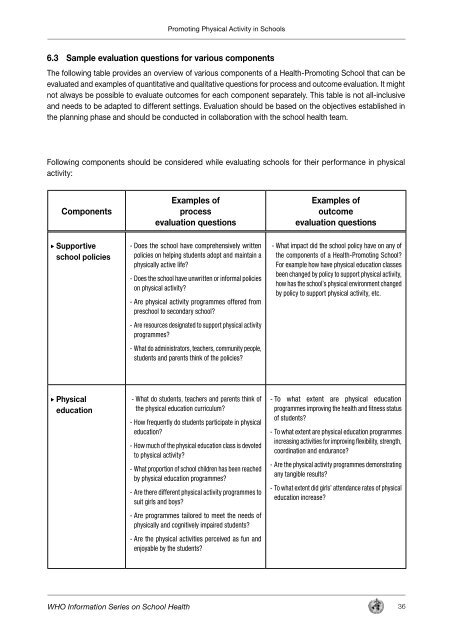WHO INFORMATION SERIES ON SCHOOL HEALTH ... - PAHO/WHO
WHO INFORMATION SERIES ON SCHOOL HEALTH ... - PAHO/WHO
WHO INFORMATION SERIES ON SCHOOL HEALTH ... - PAHO/WHO
Create successful ePaper yourself
Turn your PDF publications into a flip-book with our unique Google optimized e-Paper software.
Promoting Physical Activity in Schools<br />
6.3 Sample evaluation questions for various components<br />
The following table provides an overview of various components of a Health-Promoting School that can be<br />
evaluated and examples of quantitative and qualitative questions for process and outcome evaluation. It might<br />
not always be possible to evaluate outcomes for each component separately. This table is not all-inclusive<br />
and needs to be adapted to different settings. Evaluation should be based on the objectives established in<br />
the planning phase and should be conducted in collaboration with the school health team.<br />
Following components should be considered while evaluating schools for their performance in physical<br />
activity:<br />
Components<br />
Supportive<br />
school policies<br />
Physical<br />
education<br />
Examples of<br />
process<br />
evaluation questions<br />
- Does the school have comprehensively written<br />
policies on helping students adopt and maintain a<br />
physically active life?<br />
- Does the school have unwritten or informal policies<br />
on physical activity?<br />
- Are physical activity programmes offered from<br />
preschool to secondary school?<br />
- Are resources designated to support physical activity<br />
programmes?<br />
- What do administrators, teachers, community people,<br />
students and parents think of the policies?<br />
- What do students, teachers and parents think of<br />
the physical education curriculum?<br />
- How frequently do students participate in physical<br />
education?<br />
- How much of the physical education class is devoted<br />
to physical activity?<br />
- What proportion of school children has been reached<br />
by physical education programmes?<br />
- Are there different physical activity programmes to<br />
suit girls and boys?<br />
- Are programmes tailored to meet the needs of<br />
physically and cognitively impaired students?<br />
- Are the physical activities perceived as fun and<br />
enjoyable by the students?<br />
Examples of<br />
outcome<br />
evaluation questions<br />
- What impact did the school policy have on any of<br />
the components of a Health-Promoting School?<br />
For example how have physical education classes<br />
been changed by policy to support physical activity,<br />
how has the school’s physical environment changed<br />
by policy to support physical activity, etc.<br />
- To what extent are physical education<br />
programmes improving the health and fitness status<br />
of students?<br />
- To what extent are physical education programmes<br />
increasing activities for improving flexibility, strength,<br />
coordination and endurance?<br />
- Are the physical activity programmes demonstrating<br />
any tangible results?<br />
- To what extent did girls’ attendance rates of physical<br />
education increase?<br />
<strong>WHO</strong> Information Series on School Health 36

















